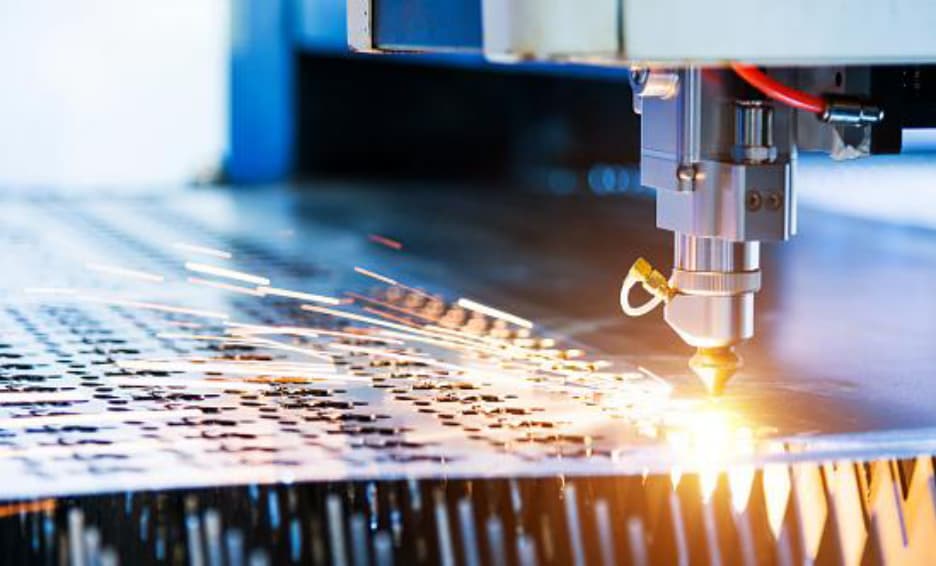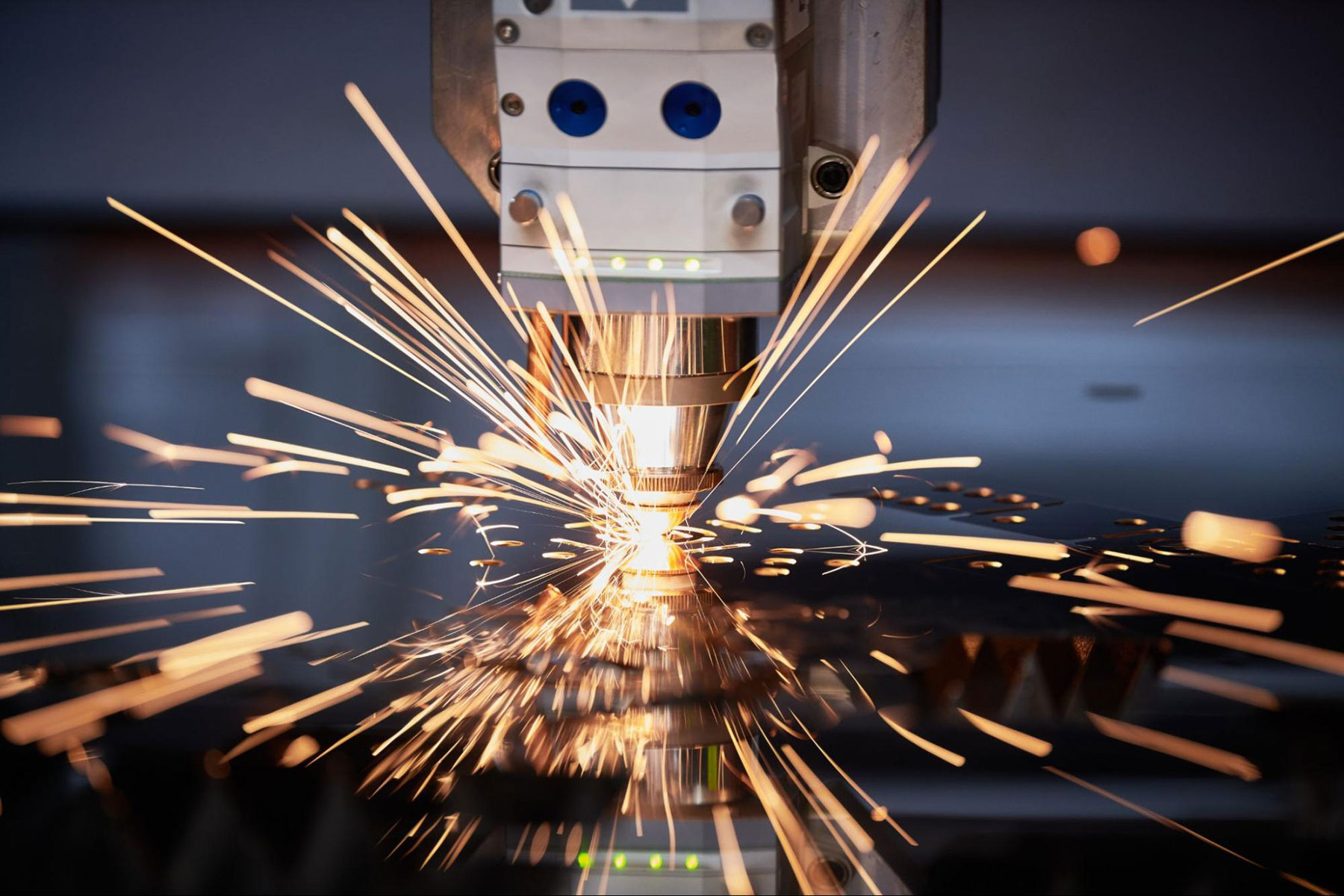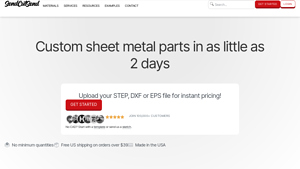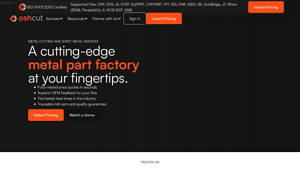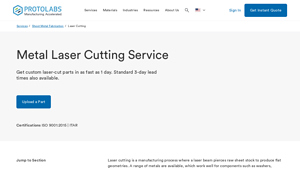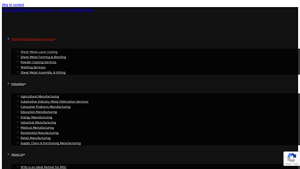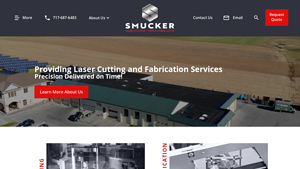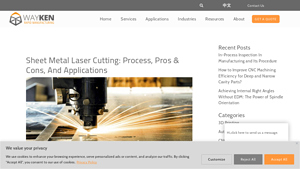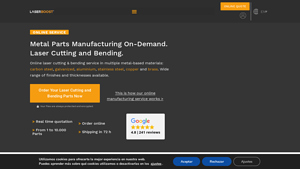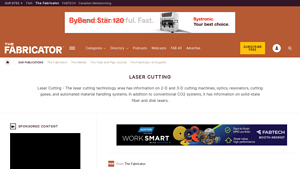Metal Fabrication Laser Cutting Guide: Type, Cost, Top List…
Introduction: Navigating the Global Market for metal fabrication laser cutting
Navigating the complexities of the global market for metal fabrication laser cutting can be a formidable challenge for international B2B buyers. As companies strive to secure high-quality components while managing costs and lead times, the need for reliable sourcing solutions becomes paramount. This comprehensive guide will delve into the various types of laser cutting technologies, applications across industries, and essential considerations for supplier vetting.
By providing insights into factors such as material selection, pricing structures, and production capabilities, this guide empowers decision-makers from regions like Africa, South America, the Middle East, and Europe—particularly in markets such as Germany and Nigeria—to make informed purchasing decisions. Understanding the nuances of the laser cutting process, including the benefits of rapid prototyping and bulk order efficiencies, enables businesses to optimize their supply chains and enhance operational efficiency.
Furthermore, we will explore the critical aspects of ensuring quality control and compliance with international standards, which are vital for fostering long-term partnerships with suppliers. Whether you are looking to cut costs, improve turnaround times, or innovate your product offerings, this guide serves as an essential resource for navigating the dynamic landscape of metal fabrication laser cutting.
Understanding metal fabrication laser cutting Types and Variations
| Type Name | Key Distinguishing Features | Primary B2B Applications | Brief Pros & Cons for Buyers |
|---|---|---|---|
| CO2 Laser Cutting | Utilizes a CO2 gas laser for cutting thicker materials; excellent for non-metal substrates. | Aerospace, automotive, signage, and HVAC sectors. | Pros: Good for thick materials; Cons: Slower cutting speed compared to fiber lasers. |
| Fiber Laser Cutting | Employs fiber optics to generate laser beams; ideal for metals; faster cutting speeds. | Electronics, medical devices, and metal fabrication. | Pros: High speed and precision; Cons: Limited to metals and some plastics. |
| Nd:YAG Laser Cutting | Uses neodymium-doped yttrium aluminum garnet; effective for precision cutting on metals. | Jewelry, aerospace, and intricate designs. | Pros: High precision; Cons: More expensive operational costs. |
| Waterjet Cutting | Utilizes high-pressure water mixed with abrasives; versatile for various materials. | Construction, automotive, and artistic applications. | Pros: No heat-affected zone; Cons: Slower than laser cutting; requires post-processing. |
| Plasma Cutting | Uses high-velocity plasma to cut through conductive materials; effective for thick metals. | Heavy machinery, shipbuilding, and metal sculptures. | Pros: Suitable for thick materials; Cons: Rougher edges; less precision than laser cutting. |
What are the characteristics of CO2 Laser Cutting in metal fabrication?
CO2 laser cutting is characterized by its ability to cut through thicker materials, making it a popular choice in industries like aerospace and automotive. This method excels in cutting non-metal substrates as well, such as wood and plastics. When considering B2B purchases, companies should evaluate the specific material thickness they require, as CO2 lasers are generally slower than fiber lasers, which may impact production timelines.
How does Fiber Laser Cutting differ from other methods?
Fiber laser cutting distinguishes itself through its use of fiber optics, allowing for faster cutting speeds and higher precision, especially with metals. This technology is particularly advantageous for industries that require rapid prototyping or high-volume production, such as electronics and medical devices. Buyers should consider the operational costs and the types of materials they plan to cut, as fiber lasers are primarily suited for metals and some plastics.
What advantages does Nd:YAG Laser Cutting offer for precision tasks?
Nd:YAG laser cutting is known for its high precision and is commonly used in applications that require intricate designs, such as jewelry and aerospace components. This method is effective for cutting metals and can achieve detailed patterns that other methods may struggle with. However, the operational costs can be higher, making it essential for B2B buyers to weigh the benefits of precision against their budget constraints.
Why choose Waterjet Cutting for diverse material needs?
Waterjet cutting is unique in that it can cut a wide variety of materials, including metals, ceramics, and composites, without introducing heat that could affect the material properties. This feature makes it ideal for construction and artistic applications where material integrity is crucial. However, buyers should note that waterjet cutting is generally slower than laser cutting and may require additional post-processing, which could impact overall project timelines.
In what scenarios is Plasma Cutting the best option?
Plasma cutting is particularly effective for cutting through thick metals, making it a favored choice in industries like shipbuilding and heavy machinery. This method operates by using high-velocity plasma, which can handle substantial material thicknesses. While plasma cutting is faster than laser cutting for thick materials, it typically results in rougher edges and less precision, so B2B buyers should assess the quality requirements of their projects before opting for this method.
Key Industrial Applications of metal fabrication laser cutting
| Industry/Sector | Specific Application of metal fabrication laser cutting | Value/Benefit for the Business | Key Sourcing Considerations for this Application |
|---|---|---|---|
| Aerospace | Manufacturing of aircraft components and brackets | High precision and lightweight parts enhance fuel efficiency and performance. | Compliance with aviation standards and certifications. |
| Automotive | Production of chassis parts and custom brackets | Reduces weight and increases structural integrity, improving vehicle safety and performance. | Material certifications and lead time flexibility. |
| Electronics | Fabrication of enclosures and circuit board mounts | Enhances product durability while allowing for intricate designs and reduced assembly time. | Compatibility with various electronic components. |
| Energy and Utilities | Creation of parts for renewable energy systems | Supports sustainability initiatives by enabling efficient energy production and distribution. | Consideration of environmental regulations and material sourcing. |
| Construction and Fabrication | Production of custom metal frameworks and supports | Facilitates rapid assembly and reduces labor costs, improving project timelines. | Customization options and scalability of production. |
How is Metal Fabrication Laser Cutting Applied in Aerospace?
In the aerospace sector, metal fabrication laser cutting is utilized for manufacturing precise aircraft components such as brackets, panels, and structural parts. The high accuracy of laser cutting ensures that parts meet stringent specifications, which is crucial for safety and performance in flight. International buyers in this sector must consider compliance with aviation standards, material certifications, and the ability to deliver on tight timelines, especially when working on projects with global supply chains.
What Role Does Metal Laser Cutting Play in Automotive Production?
The automotive industry leverages metal fabrication laser cutting for producing chassis parts and custom brackets that are essential for vehicle assembly. This technology allows for lightweight components that enhance fuel efficiency and overall vehicle performance. B2B buyers in this field should prioritize sourcing from suppliers who can provide material certifications and demonstrate flexibility in lead times to accommodate the fast-paced nature of automotive production cycles.
How is Laser Cutting Used in Electronics Manufacturing?
In electronics, laser cutting is employed to create enclosures and mounts for circuit boards. The precision offered by laser cutting allows for intricate designs that improve product durability and reduce assembly time. Buyers from this sector should focus on suppliers who can ensure compatibility with various electronic components and offer rapid prototyping services, as speed to market is critical in the competitive electronics landscape.
What Are the Applications of Laser Cutting in Energy and Utilities?
Laser cutting is vital in the energy sector, particularly for fabricating parts for renewable energy systems such as wind turbines and solar panels. This method supports sustainability initiatives by enabling the production of efficient energy components that contribute to reduced environmental impact. International buyers must consider sourcing materials that comply with environmental regulations and ensure that their suppliers can meet the specific requirements of energy projects.
How Does Metal Fabrication Laser Cutting Benefit Construction and Fabrication?
In construction, metal fabrication laser cutting facilitates the production of custom metal frameworks and supports, which are essential for efficient project assembly. The technology allows for rapid production and customization, significantly reducing labor costs and improving project timelines. For B2B buyers in this sector, it is crucial to evaluate suppliers based on their ability to provide scalable production options and the flexibility to adapt to changing project specifications.
3 Common User Pain Points for ‘metal fabrication laser cutting’ & Their Solutions
Scenario 1: Unpredictable Lead Times Impacting Project Timelines
The Problem: B2B buyers often face challenges with unpredictable lead times when ordering laser-cut metal components. This uncertainty can jeopardize project timelines, especially when multiple suppliers are involved. A buyer in the automotive industry, for instance, may require custom metal parts for assembly lines but find that their chosen supplier cannot meet the promised delivery schedule. This can lead to production delays, increased costs, and strained relationships with clients.
The Solution: To mitigate lead time issues, it is essential to partner with suppliers who offer transparent and reliable service timelines. When sourcing metal fabrication laser cutting services, buyers should look for companies that provide instant online quotes and have a proven track record of meeting deadlines. Establishing relationships with suppliers that offer expedited services can also be beneficial. For instance, opting for a supplier that guarantees shipping within a specific timeframe, such as 1-3 days for standard orders, allows buyers to plan their production schedules more effectively. Moreover, maintaining open lines of communication with suppliers about project needs can help ensure that any potential delays are communicated early, allowing for adjustments in project planning.
Scenario 2: Difficulty in Achieving Desired Precision and Quality
The Problem: Another common pain point is the struggle to achieve the desired level of precision and quality in laser-cut components. Buyers may find that the parts received do not meet their specifications, leading to additional costs for rework or scrapped materials. For example, a construction firm might need precision-cut metal brackets for structural support but ends up with poorly finished components that do not fit as intended, causing delays and increased labor costs.
The Solution: To ensure the highest quality and precision, buyers should engage in thorough pre-production discussions with their laser cutting suppliers. Providing detailed CAD files and adhering to design guidelines is crucial; suppliers often have specific requirements for file formats, tolerances, and material thicknesses that must be met for optimal results. Additionally, buyers should consider requesting samples or prototypes before placing large orders. This allows them to assess the quality and fit of the components firsthand. Leveraging suppliers that offer value-added services like deburring and edge finishing can also enhance product quality, ensuring components are safe and ready for immediate use upon delivery.
Scenario 3: Managing Costs with Fluctuating Material Prices
The Problem: B2B buyers frequently encounter challenges related to fluctuating material prices in the metal fabrication industry. For instance, a buyer in the electronics sector may find that the cost of aluminum has surged unexpectedly, impacting their budget for laser-cut enclosures. This unpredictability can complicate financial planning and project profitability, leading to decision-making dilemmas about whether to proceed with production or seek alternative materials.
The Solution: To effectively manage costs, buyers should consider establishing long-term relationships with trusted suppliers who can offer fixed pricing agreements or volume discounts. By negotiating contracts that lock in prices for specific materials, businesses can protect themselves against sudden market fluctuations. Additionally, exploring alternative materials that meet the same functional requirements but are less volatile in pricing can also provide a buffer against cost increases. For instance, using cold-rolled steel instead of aluminum for certain applications may result in cost savings without compromising quality. Finally, utilizing advanced quoting tools offered by suppliers can help buyers quickly assess costs based on current market conditions, allowing for more informed purchasing decisions.
Strategic Material Selection Guide for metal fabrication laser cutting
What Are the Key Properties of Common Materials Used in Metal Fabrication Laser Cutting?
When selecting materials for metal fabrication laser cutting, it’s essential to consider their properties, advantages, and limitations. This analysis focuses on four common materials: Mild Steel, Stainless Steel, Aluminum, and Brass. Each material has unique characteristics that influence their suitability for various applications.
Mild Steel: A Cost-Effective Choice for General Fabrication
Mild steel, or carbon steel, is widely used in laser cutting due to its affordability and versatility. It typically has a tensile strength of around 370 MPa and can withstand moderate temperatures. Mild steel is relatively easy to cut and form, making it an excellent choice for a range of applications, including structural components and automotive parts.
Pros:
– Cost-effective and widely available.
– Good weldability and machinability.
– Suitable for various applications, including automotive and construction.
Cons:
– Susceptible to corrosion without protective coatings.
– Lower strength compared to other metals like stainless steel.
– Requires post-processing treatments for durability.
Impact on Application:
Mild steel is compatible with various media, including air and water, but it may not be suitable for corrosive environments without protective coatings.
Considerations for International Buyers:
Buyers should be aware of local standards (e.g., ASTM A36) and consider the availability of protective coatings to enhance corrosion resistance, especially in humid climates like those in parts of Africa and South America.
Stainless Steel: Durable and Corrosion-Resistant
Stainless steel is renowned for its corrosion resistance and durability, making it ideal for applications in harsh environments. It has a tensile strength ranging from 520 to 800 MPa, depending on the grade. Common grades include 304 and 316, with 316 offering superior resistance to pitting and corrosion.
Pros:
– Excellent corrosion resistance and durability.
– High strength-to-weight ratio.
– Suitable for food processing, medical, and marine applications.
Cons:
– Higher cost compared to mild steel.
– More challenging to cut due to its hardness.
– Requires specialized equipment for processing.
Impact on Application:
Stainless steel is compatible with a wide range of media, including acidic and saline environments, making it suitable for industries like food and beverage, pharmaceuticals, and marine applications.
Considerations for International Buyers:
Compliance with standards such as ASTM A240 is crucial. Buyers in Europe and the Middle East should ensure that the specific grade meets local regulations for food safety and environmental impact.
Aluminum: Lightweight and Versatile
Aluminum is favored for its lightweight and high strength-to-weight ratio, making it suitable for applications where weight is a critical factor, such as in aerospace and automotive industries. Common alloys like 6061 and 5052 offer good machinability and corrosion resistance.
Pros:
– Lightweight and easy to handle.
– Good corrosion resistance and thermal conductivity.
– Easily formed and welded.
Cons:
– More expensive than mild steel.
– Lower strength compared to stainless steel.
– Can be more challenging to cut due to its thermal properties.
Impact on Application:
Aluminum is compatible with various media but is not suitable for environments with high temperatures or exposure to certain chemicals, which can lead to degradation.
Considerations for International Buyers:
Buyers should consider the specific aluminum alloy and its compliance with international standards (e.g., ASTM B221). In regions like Africa and South America, sourcing may be limited, impacting availability and cost.
Brass: A Specialized Material for Specific Applications
Brass, an alloy of copper and zinc, is less common in general fabrication but is valued for its machinability and aesthetic appeal. It offers good corrosion resistance and is often used in plumbing and electrical applications.
Pros:
– Excellent machinability and formability.
– Good corrosion resistance, especially in marine environments.
– Attractive finish for decorative applications.
Cons:
– Higher cost compared to mild steel and aluminum.
– Limited structural strength.
– Not suitable for high-temperature applications.
Impact on Application:
Brass is compatible with water and various chemicals, making it ideal for plumbing and electrical components.
Considerations for International Buyers:
Buyers should be aware of the specific grades of brass and their compliance with standards such as ASTM B36. In regions with a high demand for plumbing materials, sourcing may be more accessible.
Summary Table of Material Selection for Metal Fabrication Laser Cutting
| Material | Typical Use Case for Metal Fabrication Laser Cutting | Key Advantage | Key Disadvantage/Limitation | Relative Cost (Low/Med/High) |
|---|---|---|---|---|
| Mild Steel | Structural components, automotive parts | Cost-effective and widely available | Susceptible to corrosion | Low |
| Stainless Steel | Food processing, medical, marine applications | Excellent corrosion resistance | Higher cost and harder to cut | High |
| Aluminum | Aerospace, automotive, lightweight structures | Lightweight and easy to handle | More expensive and lower strength | Medium |
| Brass | Plumbing, electrical components | Excellent machinability | Limited structural strength | Medium |
In-depth Look: Manufacturing Processes and Quality Assurance for metal fabrication laser cutting
What Are the Main Stages in the Manufacturing Process of Metal Fabrication Laser Cutting?
Metal fabrication through laser cutting involves several essential stages, each critical to ensuring that the final product meets the desired specifications. The main stages include material preparation, forming, assembly, and finishing.
How is Material Prepared for Laser Cutting?
The first step in the manufacturing process is material preparation. This involves selecting the appropriate type of metal, which could range from aluminum to stainless steel, depending on the application requirements. Once the material is chosen, it is cut into manageable sheets or rolls. The preparation phase also includes cleaning the surface to remove any contaminants that could affect the laser cutting process.
In B2B contexts, buyers should look for suppliers that provide detailed material certifications, ensuring compliance with international standards. Suppliers often use laser cutting machines equipped with advanced technology that allows for precise measurements and adjustments to accommodate various material thicknesses.
What Techniques Are Used in the Forming Stage?
After material preparation, the forming stage takes place. This involves using a laser beam to precisely cut the metal into the desired shapes. The laser cutting process can be categorized into two primary techniques: CO2 laser cutting and fiber laser cutting. CO2 lasers are effective for cutting thicker materials, while fiber lasers excel in speed and precision for thinner materials.
During this stage, it is crucial to maintain optimal laser settings, including power, speed, and focus, to achieve high-quality cuts. The technology used should also facilitate real-time monitoring, allowing for adjustments to be made on the fly to prevent defects.
How is the Assembly Process Managed in Laser Cutting?
The assembly phase involves integrating various components that have been laser cut. This might include adding hardware, such as nuts and bolts, or assembling multiple parts into a final product. Quality assurance during assembly is paramount; thus, manufacturers often implement standardized procedures to ensure consistency.
For B2B buyers, understanding a supplier’s assembly capabilities is essential. Suppliers should be able to provide clear documentation on assembly methods and any relevant certifications that demonstrate compliance with industry standards.
What Finishing Techniques Are Commonly Used After Laser Cutting?
The final stage in the manufacturing process is finishing. This can include deburring, which smooths out sharp edges, and surface treatments such as anodizing, plating, or powder coating. Finishing not only enhances the aesthetic appeal of the parts but also improves their durability and resistance to corrosion.
For international B2B buyers, it is important to inquire about the finishing techniques available and their compliance with environmental regulations. Suppliers should be transparent about their processes and any certifications they hold, ensuring that the finishing methods used are safe and effective.
What Quality Control Measures Are Essential for Laser Cutting?
Quality control (QC) is a critical component of the laser cutting manufacturing process. It ensures that the products meet the specified requirements and are free from defects. Various international standards, such as ISO 9001:2015, provide frameworks for quality management systems that organizations can adopt.
How Are International Standards Relevant to B2B Buyers?
For buyers from diverse regions, such as Africa, South America, the Middle East, and Europe, understanding the significance of international standards is crucial. ISO certifications indicate that a supplier adheres to globally recognized quality management practices. Buyers should prioritize suppliers that hold relevant certifications, as this can significantly reduce the risk of receiving subpar products.
What Are the Key QC Checkpoints in the Manufacturing Process?
The QC process typically includes several checkpoints:
-
Incoming Quality Control (IQC): This involves inspecting raw materials upon arrival to ensure they meet specifications before they are used in production.
-
In-Process Quality Control (IPQC): During manufacturing, regular inspections are conducted to monitor the process and identify any deviations from quality standards.
-
Final Quality Control (FQC): After the manufacturing process, a thorough inspection is performed on the finished products to verify that they meet all specifications and quality standards.
By maintaining rigorous QC checkpoints, manufacturers can ensure that defects are identified and rectified at various stages of production.
What Common Testing Methods Are Used in Quality Control?
Several testing methods are commonly employed in the QC process for laser-cut metal components:
-
Visual Inspection: This is the most basic form of inspection, where products are examined for visible defects.
-
Dimensional Inspection: Precision measuring tools are used to verify that the dimensions of the finished parts meet the specified tolerances.
-
Material Testing: This can include tensile testing, hardness testing, and chemical composition analysis to ensure that the material properties meet the required standards.
B2B buyers should inquire about the specific testing methods employed by their suppliers and request access to testing reports as part of their due diligence.
How Can B2B Buyers Verify Supplier Quality Control Processes?
For international buyers, verifying a supplier’s QC processes can be challenging but is essential for ensuring product quality. Here are some effective strategies:
-
Supplier Audits: Conducting audits of potential suppliers can provide insight into their manufacturing processes and quality assurance practices. This can be done in person or through third-party auditing services.
-
Requesting Quality Reports: Buyers should ask suppliers for detailed quality reports, including results from IQC, IPQC, and FQC. This documentation should also include certifications and compliance with international standards.
-
Third-Party Inspections: Engaging third-party inspection services can provide an unbiased assessment of the supplier’s quality control practices and the products being delivered.
What Are the Quality Control Nuances for International Buyers?
International B2B buyers must navigate various challenges related to quality control, particularly concerning local regulations, cultural differences, and communication barriers. It is crucial to establish clear expectations with suppliers regarding quality standards and compliance.
Additionally, understanding the logistics involved in international shipping and how it may affect product quality is important. Buyers should work closely with suppliers to ensure that quality standards are maintained throughout the supply chain, from production to delivery.
By being proactive in understanding and verifying quality control processes, B2B buyers can significantly reduce risks and ensure they receive high-quality laser-cut metal components that meet their specifications.
Practical Sourcing Guide: A Step-by-Step Checklist for ‘metal fabrication laser cutting’
Introduction
This sourcing guide provides a step-by-step checklist for B2B buyers looking to procure metal fabrication laser cutting services. By following this guide, you can ensure that you partner with the right suppliers, meet your technical requirements, and optimize your production efficiency.
1. Define Your Technical Specifications
Clearly outline your project requirements, including dimensions, material types, and tolerances. This step is vital to communicate your needs effectively to potential suppliers and ensures that you receive accurate quotes and samples that meet your expectations. Consider factors such as:
– Material types: Aluminum, stainless steel, or carbon steel.
– Thickness requirements: Specify the range to avoid misunderstandings.
2. Research Potential Suppliers
Conduct thorough research to identify suppliers with a proven track record in metal fabrication laser cutting. Look for companies that specialize in your required materials and have experience in your industry. Use online directories, trade shows, and industry forums to gather information. Focus on:
– Customer reviews: Assess their reputation through testimonials and case studies.
– Industry certifications: Verify ISO certifications or other relevant qualifications.
3. Request Detailed Quotes
Once you have a shortlist of suppliers, request detailed quotes that break down costs associated with material, labor, and additional services like finishing. A comprehensive quote allows you to compare offers fairly and understand the value provided. Pay attention to:
– Lead times: Ensure they align with your project timeline.
– Minimum order quantities: Confirm that their policies match your needs.
4. Verify Supplier Certifications
Ensure that the suppliers you are considering hold relevant certifications, such as ISO 9001, which indicates a commitment to quality management. This verification is crucial as it reflects the supplier’s adherence to industry standards and regulations. Look for:
– Quality assurance processes: Understand their approach to quality control.
– Compliance with local regulations: Confirm they meet specific regional requirements.
5. Evaluate Production Capabilities
Assess the production capabilities of each potential supplier. This includes their technology, machinery, and workforce qualifications. A supplier with advanced laser cutting technology can provide better precision and efficiency, which is essential for high-quality outcomes. Consider:
– Capacity for scale: Can they handle both small and large orders?
– Post-processing options: Do they offer additional services such as bending or plating?
6. Request Samples and Prototypes
Before finalizing your supplier, request samples or prototypes of their work. This step allows you to evaluate the quality of their output firsthand and ensures that they can meet your specifications. Assess:
– Precision: Check for adherence to specified tolerances.
– Finish quality: Evaluate the smoothness and overall appearance of the cuts.
7. Establish Communication Channels
Finally, ensure that clear communication channels are established with your chosen supplier. Effective communication is key to managing expectations and addressing any issues that may arise during production. Look for:
– Dedicated account management: A contact person who understands your needs.
– Response times: Quick and effective responses to inquiries reflect their commitment to customer service.
By following this checklist, you can streamline your sourcing process for metal fabrication laser cutting, ensuring that you choose a supplier that aligns with your business goals and technical requirements.
Comprehensive Cost and Pricing Analysis for metal fabrication laser cutting Sourcing
What Are the Key Cost Components in Metal Fabrication Laser Cutting?
Understanding the cost structure of metal fabrication laser cutting is crucial for B2B buyers. The primary cost components include:
-
Materials: The choice of metal significantly impacts pricing. Common materials such as aluminum, stainless steel, and carbon steel vary in cost based on thickness and grade. For instance, aluminum grades like 5052 and 6061 are popular but may command a premium over lower-grade steels.
-
Labor: Skilled labor is essential for operating laser cutting machinery and ensuring quality output. Labor costs can fluctuate based on the region, skill level required, and complexity of the job.
-
Manufacturing Overhead: This includes costs related to facility operations, utilities, and equipment maintenance. High-capacity manufacturers may achieve economies of scale, reducing overhead per unit as production volume increases.
-
Tooling: Investment in specialized tools and equipment for laser cutting processes must be factored into overall costs. Custom tooling for specific designs can further escalate expenses.
-
Quality Control (QC): Ensuring that parts meet specified tolerances and quality standards involves additional costs. Certifications such as ISO 9001:2015 may also add to the initial pricing but ensure reliability and compliance.
-
Logistics: Shipping costs can be significant, especially for international buyers. Factors such as distance, mode of transport, and customs duties should be considered.
-
Margin: Suppliers will include a profit margin in their pricing, which can vary based on market conditions and competitive landscape.
How Do Price Influencers Affect Metal Fabrication Laser Cutting Costs?
Several factors can influence pricing in the metal fabrication laser cutting market:
-
Volume and Minimum Order Quantity (MOQ): Generally, higher order quantities lead to lower per-unit costs due to economies of scale. Suppliers often have minimum order requirements that can impact pricing for smaller orders.
-
Specifications and Customization: Custom designs with intricate specifications can increase costs. Simple, standardized parts are typically cheaper to produce.
-
Materials: The choice of material not only affects the base price but also influences processing costs. For example, harder materials may require more advanced cutting techniques, increasing labor and overhead.
-
Quality and Certifications: Parts that require higher quality standards or specific certifications will incur additional costs. Buyers should weigh the necessity of certifications against their project requirements.
-
Supplier Factors: Supplier reliability, lead times, and geographic location can all impact pricing. Local suppliers may offer faster shipping but might charge a premium compared to overseas options.
-
Incoterms: The agreed terms of shipment (e.g., FOB, CIF) can influence total costs. Understanding Incoterms is essential for budgeting logistics expenses accurately.
What Are the Best Tips for B2B Buyers Seeking Cost-Efficiency in Laser Cutting?
Navigating the complexities of cost and pricing in metal fabrication laser cutting requires strategic insight. Here are actionable tips for international B2B buyers:
-
Negotiate: Engage suppliers in discussions about pricing, especially for bulk orders. Leverage competitive quotes to negotiate better terms.
-
Consider Total Cost of Ownership (TCO): Look beyond initial pricing. Factor in logistics, quality control, and potential rework costs. A slightly higher upfront price may yield long-term savings if it results in fewer defects.
-
Evaluate Pricing Nuances for International Buyers: Be aware of currency fluctuations, import duties, and taxes when sourcing from abroad. These factors can significantly affect the total cost.
-
Standardize Designs: Where possible, standardize parts to reduce complexity and cost. This can lead to more competitive pricing and faster production times.
-
Build Relationships: Establishing long-term relationships with suppliers can lead to better pricing, priority in production, and improved service levels.
Disclaimer on Pricing
Prices for metal fabrication laser cutting services can vary widely based on the factors discussed above. Buyers are encouraged to request quotes based on specific project requirements and understand that indicative prices may change based on market conditions and supplier capabilities.
Alternatives Analysis: Comparing metal fabrication laser cutting With Other Solutions
When considering metal fabrication processes, it’s essential to evaluate various cutting technologies to determine which best meets your production needs. Metal fabrication laser cutting has gained popularity due to its precision and efficiency, but other methods may also provide viable alternatives depending on specific requirements such as material type, budget, and project scope. This analysis compares metal fabrication laser cutting with two other prominent cutting technologies: waterjet cutting and CNC machining.
Comparison Table
| Comparison Aspect | Metal Fabrication Laser Cutting | Waterjet Cutting | CNC Machining |
|---|---|---|---|
| Performance | High precision with tight tolerances; ideal for intricate designs. | Excellent for thick materials; no heat-affected zone. | High precision; versatile for various shapes and sizes. |
| Cost | Moderate; costs can rise with complexity and material type. | Generally higher due to waterjet maintenance and operation. | Varies widely based on complexity; can be economical for large batches. |
| Ease of Implementation | Requires CAD files for setup; relatively quick turnaround. | Less dependent on CAD; slower setup time due to material handling. | Requires detailed programming; longer lead times for complex parts. |
| Maintenance | Low; routine checks on optics and calibration needed. | Moderate; pumps and nozzles require regular maintenance. | Moderate to high; wear on tools and parts can incur additional costs. |
| Best Use Case | Ideal for thin to medium materials, complex designs, and rapid prototyping. | Best for thick materials and applications requiring minimal thermal distortion. | Suitable for high-volume production of parts with complex geometries. |
Detailed Breakdown of Alternatives
Waterjet Cutting
Waterjet cutting utilizes a high-pressure jet of water, often mixed with abrasive materials, to cut through a variety of materials. This method excels in cutting thick materials without generating heat, which prevents warping or altering the material properties.
Pros: Waterjet cutting is versatile and can handle materials that are difficult to laser cut, such as composites and ceramics. It also produces a smooth finish without the need for secondary processes.
Cons: The operational costs are typically higher than laser cutting due to the maintenance of the waterjet system and the abrasive materials used. Additionally, the speed of waterjet cutting can be slower compared to laser cutting, which may impact production timelines.
CNC Machining
CNC (Computer Numerical Control) machining employs rotating cutting tools to remove material from a workpiece. This method is highly flexible and can produce complex parts with high accuracy.
Pros: CNC machining is suitable for a wide range of materials and thicknesses, making it an excellent choice for custom parts. It also allows for intricate designs and can produce parts with tight tolerances.
Cons: The initial setup for CNC machining can be time-consuming, especially for complex designs, leading to longer lead times. Additionally, the cost can escalate with the complexity of the part and the wear on tools over time, making it less economical for low-volume production.
Conclusion: How to Choose the Right Metal Fabrication Solution
Selecting the appropriate metal fabrication method depends on various factors, including material type, production volume, and budget constraints. Laser cutting is ideal for projects requiring precision and speed, particularly with thin to medium materials. Waterjet cutting shines in applications needing minimal thermal impact and the ability to cut thick materials, while CNC machining offers versatility for complex designs but may require more time and investment. B2B buyers should assess their specific project requirements, including turnaround time and cost-efficiency, to make an informed decision on the best cutting technology for their needs.
Essential Technical Properties and Trade Terminology for metal fabrication laser cutting
What Are the Key Technical Properties in Metal Fabrication Laser Cutting?
Understanding the essential technical properties of laser cutting in metal fabrication is crucial for B2B buyers. Here are some of the critical specifications:
Material Grade
Material grade refers to the quality and composition of the metal used in fabrication. Common grades include stainless steel (e.g., 304, 316), aluminum (e.g., 5052, 6061), and various carbon steels. Selecting the appropriate material grade is vital for ensuring the durability and functionality of the final product, especially in demanding applications like aerospace or automotive sectors.
Tolerance
Tolerance indicates the permissible limit of variation in a dimension. For laser-cut parts, a typical tolerance might be ±0.005 inches. Tighter tolerances are essential for components that require precise fitting, such as in machinery or electronic devices. Understanding tolerances helps in assessing whether a supplier can meet specific project requirements.
Thickness
The thickness of the material being cut significantly impacts the laser cutting process. Common thicknesses range from 0.024 inches to 0.250 inches, depending on the material. Thicker materials may require more powerful lasers and longer cutting times. B2B buyers must consider thickness when planning projects to ensure the chosen service can accommodate their specifications.
Surface Finish
Surface finish refers to the texture of the cut edges, which can affect both aesthetics and functionality. Finishing options include deburring, anodizing, and powder coating. A good surface finish can enhance corrosion resistance and improve the overall appearance of the part, making it crucial for industries where visual quality is paramount.
Lead Time
Lead time is the duration from order placement to delivery. In laser cutting, expedited services may allow for delivery in as little as one day, while standard services might take three days. Understanding lead times helps businesses plan their production schedules and inventory management effectively.
What Are Common Terms in Metal Fabrication Laser Cutting?
Familiarity with industry jargon is essential for effective communication and decision-making. Here are some common trade terms:
OEM (Original Equipment Manufacturer)
An OEM is a company that produces parts or equipment that may be marketed by another manufacturer. In the context of laser cutting, OEMs often require custom components that meet specific standards. Understanding OEM relationships can aid buyers in navigating their supply chain effectively.
MOQ (Minimum Order Quantity)
MOQ refers to the smallest quantity of a product that a supplier is willing to sell. In laser cutting, MOQs can vary significantly between suppliers, impacting order flexibility for businesses. Buyers should be aware of MOQ requirements to optimize their purchasing strategy.
RFQ (Request for Quotation)
An RFQ is a document used to invite suppliers to bid on a project by providing pricing and terms for specified goods or services. It is crucial for B2B buyers to issue RFQs to ensure they receive competitive offers and can compare different suppliers effectively.
Incoterms (International Commercial Terms)
Incoterms are standardized trade terms that define the responsibilities of buyers and sellers regarding shipping, insurance, and tariffs. Familiarity with Incoterms is vital for international transactions, as they help clarify who is responsible for costs and risks during transportation.
CAD (Computer-Aided Design)
CAD refers to software used to create precision drawings or technical illustrations. In laser cutting, CAD files are often required for accurate cutting and fabrication. Understanding CAD’s role can streamline the design and ordering process for buyers.
By grasping these technical properties and trade terms, B2B buyers can make informed decisions that enhance project outcomes and foster successful supplier relationships in the metal fabrication laser cutting industry.
Navigating Market Dynamics and Sourcing Trends in the metal fabrication laser cutting Sector
What are the Current Market Dynamics and Key Trends in Metal Fabrication Laser Cutting?
The global metal fabrication laser cutting market is experiencing transformative growth driven by several factors. The increasing demand for precision and efficiency in manufacturing processes is a primary driver. Industries such as automotive, aerospace, and electronics are increasingly adopting laser cutting for its ability to produce intricate designs with minimal waste. This trend is especially pronounced in regions like Europe and North America, where high-quality standards and rapid prototyping capabilities are critical.
Emerging technologies, such as automation and AI-driven processes, are also reshaping the market landscape. These advancements enable faster turnaround times and improved accuracy, making laser cutting services more appealing to international buyers. Additionally, the rise of online platforms offering instant quoting and order tracking is streamlining the procurement process, allowing buyers from Africa, South America, the Middle East, and Europe to access services quickly and efficiently. The shift toward on-demand manufacturing is particularly relevant in these regions, where flexibility in production is often necessary to meet diverse market needs.
Moreover, the trend toward customization is gaining traction. Buyers are increasingly looking for suppliers that can accommodate unique specifications, whether it’s for small batch runs or large-scale production. This shift emphasizes the importance of supplier capabilities in handling varied materials and thicknesses, as well as offering value-added services like deburring and finishing. In summary, the laser cutting sector is evolving rapidly, driven by technological advancements, demand for customization, and the need for efficiency in international supply chains.
How is Sustainability and Ethical Sourcing Influencing the Metal Fabrication Sector?
Sustainability and ethical sourcing have become pivotal considerations for B2B buyers in the metal fabrication laser cutting sector. As industries face mounting pressure to reduce their environmental footprint, the demand for sustainable practices is growing. Buyers are increasingly prioritizing suppliers that demonstrate commitment to environmental stewardship through the use of recycled materials and energy-efficient processes.
The impact of metal fabrication on the environment is significant, with energy-intensive processes and waste generation being common challenges. Thus, selecting suppliers with certifications such as ISO 14001 (Environmental Management) or those that offer green materials can enhance a company’s sustainability profile. Such certifications not only reflect a supplier’s commitment to reducing environmental impact but also assure buyers of compliance with international sustainability standards.
Furthermore, transparency in the supply chain is crucial. Buyers are keen on understanding the sourcing of materials, labor practices, and overall ethical standards of their suppliers. Engaging with suppliers that emphasize ethical sourcing can help mitigate risks associated with social and environmental governance (ESG). This focus on sustainability and ethics not only aligns with global trends but also enhances brand reputation, making it a critical consideration for B2B buyers in today’s market.
What is the Historical Context of Metal Fabrication Laser Cutting?
The evolution of metal fabrication laser cutting can be traced back to the 1960s when the first industrial laser was developed. Initially, laser cutting technology was primarily utilized in the aerospace sector for its precision and ability to cut complex shapes. Over the decades, advancements in laser technology, including the development of fiber lasers, have significantly improved cutting speeds and material versatility.
By the late 1990s and early 2000s, the technology became more accessible, leading to widespread adoption across various industries. Today, laser cutting is recognized not only for its efficiency and precision but also for its ability to enhance product designs and reduce waste. The historical journey of this technology has set the stage for its current prominence in the global market, making it an indispensable tool for modern manufacturing processes.
In conclusion, understanding these dynamics, sustainability considerations, and historical advancements can significantly enhance the decision-making process for B2B buyers in the metal fabrication laser cutting sector.
Frequently Asked Questions (FAQs) for B2B Buyers of metal fabrication laser cutting
-
How do I ensure quality when sourcing metal fabrication laser cutting services?
To ensure quality, consider suppliers with ISO certifications, as these indicate adherence to international quality standards. Request samples of previous work to assess their capabilities and finish. Additionally, inquire about their quality assurance processes, such as in-house inspections and testing. Establishing clear communication regarding your specifications and tolerances can also help mitigate risks associated with quality discrepancies. -
What materials can I use for laser cutting in metal fabrication?
Common materials for laser cutting include various grades of steel (mild, stainless, and galvanized), aluminum (5052, 6061), brass, and copper. Each material has specific thicknesses suitable for laser cutting, typically ranging from 0.024 inches to 0.250 inches. When choosing materials, consider factors such as application, mechanical properties, and corrosion resistance to ensure the best fit for your project. -
What are the typical lead times for laser-cut metal parts?
Lead times can vary significantly based on the supplier, order complexity, and quantity. Standard lead times for laser cutting range from 2 to 4 days for smaller orders, while expedited services may deliver parts in as little as 1 day. It’s essential to discuss your timeline requirements upfront and ensure the supplier can meet your deadlines, especially for international shipments that may involve additional logistics considerations. -
Are there minimum order quantities (MOQs) for laser cutting services?
Many laser cutting suppliers have flexible MOQs, allowing for both single-part orders and larger batch production. Some suppliers cater specifically to small businesses and prototyping needs, often accepting orders with no minimum requirements. However, be aware that lower quantities may result in higher per-unit costs, so it’s advisable to balance your order size with budget constraints. -
How do I vet a laser cutting supplier for international trade?
When vetting suppliers, look for established companies with a proven track record in international transactions. Check for customer reviews and testimonials, and consider their experience in shipping to your region. Request certifications and inquire about their compliance with international trade regulations. Establishing direct communication can also help you gauge their reliability and responsiveness. -
What payment terms should I expect when sourcing laser cutting services?
Payment terms can vary widely among suppliers. Common arrangements include upfront payments, partial payments upon order confirmation, or net payment terms after delivery. When negotiating, consider the supplier’s payment preferences and your cash flow requirements. Always clarify terms in your contract to avoid misunderstandings and ensure secure transactions. -
Can I customize designs for laser-cut parts?
Yes, most laser cutting services allow for extensive customization of designs. You can upload your CAD files or sketches, specifying dimensions, materials, and finishes. Suppliers often provide design guidelines to help you optimize your parts for laser cutting, ensuring manufacturability while meeting your specific requirements. Discussing your design with the supplier’s engineering team can further enhance the customization process. -
What logistics considerations should I keep in mind when ordering laser-cut parts internationally?
When ordering internationally, consider shipping methods, customs regulations, and potential tariffs. Work with suppliers who offer transparent logistics support and can provide shipping options tailored to your needs. Additionally, factor in delivery times and any local import regulations that may affect your shipment. Clear communication with your supplier about logistics can help ensure a smooth delivery process.
Important Disclaimer & Terms of Use
⚠️ Important Disclaimer
The information provided in this guide, including content regarding manufacturers, technical specifications, and market analysis, is for informational and educational purposes only. It does not constitute professional procurement advice, financial advice, or legal advice.
While we have made every effort to ensure the accuracy and timeliness of the information, we are not responsible for any errors, omissions, or outdated information. Market conditions, company details, and technical standards are subject to change.
B2B buyers must conduct their own independent and thorough due diligence before making any purchasing decisions. This includes contacting suppliers directly, verifying certifications, requesting samples, and seeking professional consultation. The risk of relying on any information in this guide is borne solely by the reader.
Top 8 Metal Fabrication Laser Cutting Manufacturers & Suppliers List
1. SendCutSend – Custom Sheet Metal Fabrication
Domain: sendcutsend.com
Registered: 2015 (10 years)
Introduction: SendCutSend offers custom sheet metal fabrication services, including laser cutting, CNC routing, waterjet cutting, bending, anodizing, and more. Key features include:
– Custom sheet metal parts available in as little as 2 days.
– Instant pricing by uploading STEP, DXF, or EPS files.
– No minimum quantities required.
– Free US shipping on orders over $39.
– Materials include cold rolled carbon ste…
2. Oshcut – Laser Cutting & Sheet Metal Services
Domain: oshcut.com
Registered: 2018 (7 years)
Introduction: Laser Cutting and Sheet Metal Services, 2-day delivery throughout the US, Online DFM/Ordering, Laser Metal Cutting, Laser Tube Cutting, Flat Finishing, Bending, Metal Tapping, Bead Blasting, Centrifugal Tumbling, Powder Coating, ISO 9001:2015 Certified, Supported Files: DXF, SVG, AI, STEP, SLDPRT, CATPART, IPT, IGS, PAR, IGES, NX, SolidEdge, JT, Rhino (3DM), Parasolid (x_t), ACIS (SAT, SAB), Insta…
3. Proto Labs – Metal Laser Cutting Service
Domain: protolabs.com
Registered: 2006 (19 years)
Introduction: Metal Laser Cutting Service offers custom laser-cut parts with a fast turnaround of as little as 1 day, with standard lead times of 3 days. The service utilizes a laser beam to pierce raw sheet stock to create flat geometries. A variety of metals are available for components such as washers, mounts, brackets, and housings. Applications include prototyping designs, testing product requirements, sca…
4. IMS – Sheet Metal Laser Cutting Services
Domain: e-ims.com
Registered: 2005 (20 years)
Introduction: Sheet Metal Laser Cutting Services offered by Integrated Manufacturing Solutions (IMS) include:
– State-of-the-Art Technology: CNC laser metal cutting system with automatic load and unload capability for efficient, operator-free cutting.
– Wide Range of Materials: Capable of cutting various metals including steel (up to 1″), aluminum (up to 3/8″), stainless steel (up to 5/8″), galvanized steel, a…
5. Smucker Laser Cutting – Precision Metal Fabrication Services
Domain: smuckerlaser.com
Registered: 2005 (20 years)
Introduction: Smucker Laser Cutting & Metal Fabrication offers laser cutting and metal fabrication services, utilizing CAD/CAM design programs to cut parts from materials such as aluminum, stainless steel, and mild steel. Their capabilities include:
– Laser Cutting Services for various industries including military, transportation, and recreational.
– Metal Fabrication services including bending, shearing, and …
6. Wayken – Sheet Metal Laser Cutting
Domain: waykenrm.com
Registered: 2013 (12 years)
Introduction: Sheet Metal Laser Cutting is a thermal cutting process that uses laser beams to melt or vaporize materials for precise cutting of metals, alloys, and non-metals. The process is controlled by Computer Numerical Control (CNC) technology, ensuring high precision and accuracy, with cuts as precise as 0.0005 inches. There are three main methods of laser cutting: Fusion Cutting (using inert gas like nit…
7. LaserBoost – Online Laser Cutting Services
Domain: laserboost.com
Registered: 2012 (13 years)
Introduction: This company, LaserBoost – Online Laser Cutting Services, is a notable entity in the market. For specific product details, it is recommended to visit their website directly.
8. The Fabricator – Laser Cutting Technology
Domain: thefabricator.com
Registered: 1999 (26 years)
Introduction: The laser cutting technology area includes information on 2-D and 3-D cutting machines, optics, resonators, cutting gases, and automated material handling systems. It covers conventional CO2 systems as well as solid-state fiber and disk lasers.
Strategic Sourcing Conclusion and Outlook for metal fabrication laser cutting
In today’s competitive landscape, strategic sourcing of metal fabrication laser cutting services offers substantial advantages for international B2B buyers. By leveraging advanced technologies and streamlined processes, companies can obtain high-quality, custom parts with quick turnaround times, enhancing operational efficiency and reducing lead times. Notably, suppliers that provide instant pricing and flexible quantity options empower buyers to make informed decisions that align with their production needs.
Investing in reliable laser cutting services not only ensures precision but also opens doors to a diverse range of materials, enabling businesses to innovate and meet the unique demands of their markets. As industries in Africa, South America, the Middle East, and Europe continue to evolve, the need for adaptable sourcing strategies becomes paramount.
Looking ahead, B2B buyers should prioritize partnerships with suppliers that demonstrate commitment to quality, rapid delivery, and comprehensive service offerings. By doing so, they can position themselves favorably within their respective markets, driving growth and sustaining competitive advantage. Engage with trusted laser cutting providers today to explore how these solutions can elevate your manufacturing capabilities and meet the future demands of your business.
